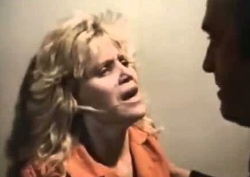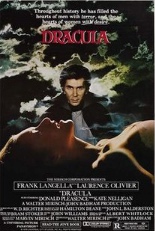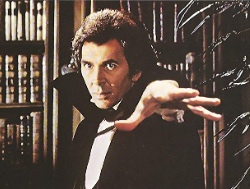
 Wisconsin filmmaker Bill Rebane’s movies have dealt with all manner of terrifying creatures, from giant spiders to Tiny Tim. Chronologically between them stands Bigfoot, in The Capture of Bigfoot. In the first line, the local redneck hunter Hank (Rebane regular William Dexter, The Demons of Ludlow) says, “We’ve only got one problem now.” Unfortunately for the viewer, that problem is the film itself, a lumbering snore of cryptozoological claptrap that reeks more foul than any sasquatch chassis.
Wisconsin filmmaker Bill Rebane’s movies have dealt with all manner of terrifying creatures, from giant spiders to Tiny Tim. Chronologically between them stands Bigfoot, in The Capture of Bigfoot. In the first line, the local redneck hunter Hank (Rebane regular William Dexter, The Demons of Ludlow) says, “We’ve only got one problem now.” Unfortunately for the viewer, that problem is the film itself, a lumbering snore of cryptozoological claptrap that reeks more foul than any sasquatch chassis.
Thanks to Hank being a dumbass, Bigfoot (Janus Raudkivi) is on the loose and looking for his child (Randolph Rebane). The local sawmill owner (Sixpack Annie’s Richard Kennedy), essentially the Carl Denham of this story, thinks there’s big money to be made in exhibiting Bigfoot to the public. The local game warden (Stafford Morgan, The Witch Who Came from the Sea) thinks Bigfoot should be left alone. The local sheriff (Wally Flaherty, The Devonsville Terror) thinks everyone want to hear his Humphrey Bogart impression.
 You’ll think Bigfoot looks more like a yeti (or a grown-up Monchhichi), what with its all-white fur, and sounds like Wolfman Jack impersonating Dracula. The beast sure keeps busy, chucking snowmobiles and tearing apart skiers, but more of the movie is given to townspeople talking about it, arguing over it, looking for it or pointing at prints of it in the snow and shouting, “Them ain’t human!”
You’ll think Bigfoot looks more like a yeti (or a grown-up Monchhichi), what with its all-white fur, and sounds like Wolfman Jack impersonating Dracula. The beast sure keeps busy, chucking snowmobiles and tearing apart skiers, but more of the movie is given to townspeople talking about it, arguing over it, looking for it or pointing at prints of it in the snow and shouting, “Them ain’t human!”
At the midpoint, Rebane offers what promises to be his pic’s pièce de résistance: a lengthy disco party suddenly interrupted by Bigfoot, who demolishes every dancer limb by limb. Only Bigfoot never shows up, so we get a lengthy disco party just for the sake of a lengthy disco party, I guess. If you manage to make it that far, marvel at the clothes and wonder where they found such fashions. Then wonder no more as the closing credits inform you: “Wardrobe and outfittings: K-Mart.” —Rod Lott

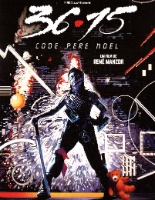
 From first frame, depicting a serene-scened snow globe shattering under the weight of a passing garbage truck, René Manzor’s
From first frame, depicting a serene-scened snow globe shattering under the weight of a passing garbage truck, René Manzor’s 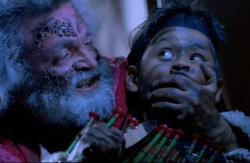
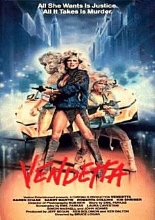
 “V” is for
“V” is for 